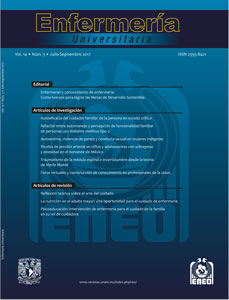Arterial pressure levels among overweighed and obese children and adolescents in Northwestern Mexico
Main Article Content
Abstract
Introduction: Child obesity is one of the main health problems in our country because of its high prevalence as well as its number of associated morbidities. High arterial pressure (AP) is a risk factor to cardiovascular disease which arises early in obese children; therefore, it is important to establish its diagnosis in early stages.
Objective: To determine the levels of AP among overweighed and obese children and adolescents in the external consultation service of a second level of attention hospital in Northwestern Mexico.
Methods: This is an observational, descriptive and transversal study with 155 children and adolescents 6 to 15 years old. Participants were asked to fill a social and demographic data questionnaire, and their weight, size, waist perimeter, and AP were obtained in accordance to international norms. The corporal mass index was calculated in order to classify the degree of adiposity of the participants in terms of the CDC-2010 criteria and tables (overweighed, obese, and very obese). The levels of AP were classified as normal, pre-hypertension, and hypertension, following the criteria proposed in the fourth report of the group for the diagnosis, assessment, and management of arterial hypertension in children and adolescents.
Results: Normal-high and high AP levels were detected in 20% and 22% of the population. High pressure levels correlated positively with the degree of adiposity.
Conclusions: The prevalence of abnormal AP levels in children with an excess of adiposity is high. Ongoing corresponding measurements should be taken on children and adolescents with risk factors.
Publication Facts
Reviewer profiles N/A
Author statements
- Academic society
- N/A
- Publisher
- Universidad Nacional Autónoma de México
Article Details
Dimensions citation
MÉTRICAS
Enfermería Universitaria by Universidad Nacional Autónoma de México it is distributed under the License Creative Commons Attribution - NonCommercial - NoDerivatives 4.0 International
Accepted and published articles become open-access under the terms of the Creative Commons CC BY-NC-ND 4.0 license, which authorizes the reproduction and sharing without commercial purposes, provided the corresponding acknowledgments to their authors. Authors are allowed to manage a self-archive copy of the article’s published version so that they can open-access it in their personal or institutional web pages, and/or any other broad-diffusion space.


